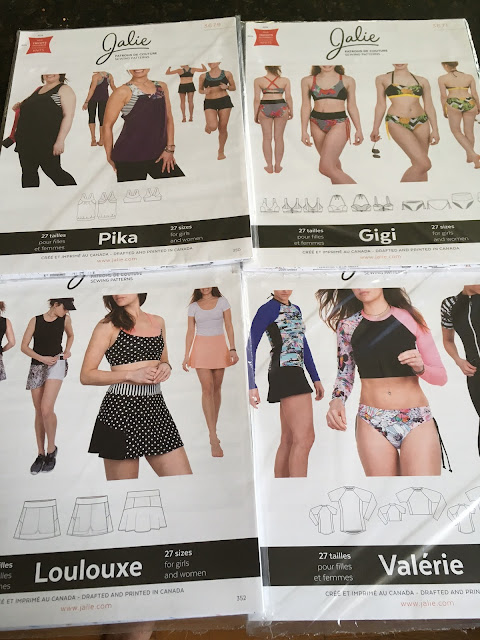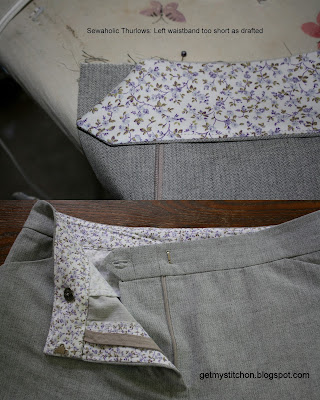Friends, I will start this post with a Public Service Announcement: Do not spend money on the Colette Rue Pattern. Even if it was $1 instead of $18, don't do it!
I warned you that this round was a doozy and was it ever!! The challenge was to make a garment using the Colette Rue dress pattern. Ugh. I don't like Colette patterns--they aren't drafted for someone with my body shape (pear) and my experience with the Hawthorn Dress left me with a wadder. So I went into this round knowing it would be a lot of work.
Although I am very burnt out thinking about this dress, I will do my best to share my journey making this horrible pattern. Upon the release of the Rue pattern Colette said they were returning to their roots-- meaning vintage inspired.
.
I downloaded & the pattern (fyi I couldn't make it print properly using Windows 8) for version 2 with the straight skirt. Even with the slimmer skirt it was 48 pages to print and assemble. There was a lot of empty space around the pattern pieces, and as one Sewing Bee contestant wisely pointed out: the Colette Logo was large, dark, and on every page which used up a lot of ink. Lots of paper, lots of taping, lots of ink wasted...it was only the beginning.
Once the pattern was assembled it was obvious from the bodice piece that I was going to be reinventing the wheel. Let's begin our photographic journey on this 'Rue' (little pun for the French speakers out there).
I printed out sizes 12, 14, & 16 using the layers in the pdf file. The ability to print only the sizes you want are
best part of this pattern. I cut out the size 12 for the bodice through the waist., based on my full bust/waist measurements of 40/33. For reference, the pattern suggested a size 12 for measurements of 40/32 (close enough even though I knew they draft for a C cup). I taped up the tucks in the paper pattern and pinned it to my dress form:
The shoulders were way too wide. I narrowed them by an inch by folding the paper and, then held it up to me:
The shoulder width was better but that thing didn't come anywhere near the tops of my shoulders! Forget about the seam line--the cutting line was way too short. I had the armhole in the right spot, the CF was in the right spot, the tucks released in the general vicinity of where they should, but the shoulders were 2" too short. I am not a tall person & I do not have a long torso... That is a very strange block Colette is using. Let's look at the pattern piece on my dress form:
Yup, 2" too short. You can see I drew in the seam line on the paper, and for the seam to hit my shoulder line, I needed to add 2 full inches. So I cut and spread the pattern piece above the armhole and added over 2", better too much than not enough. Then I raised the neckline up 2" to bring it back up where it was supposed to be.
At that point, I made my first muslin of the front bodice: aka "Big Ugly Mess"
 |
| That is not a pretty silhouette |
Pretty ugly right? So I pinned out a bunch of the excess in the center front and pinned the side panels up where they would lay smoothly.
You can see progress being made. In addition to pinning the side panel upward, I also pinched a dart out of the armhole. I rotated this dart out of the pattern piece. I felt that the tucks at the bust were not located correctly. They were pointing toward my sternum rather than to the apex. I wanted to experiment with shifting them upward along the seam.
There was definite progress, so I charged ahead with muslin #2.
I want everyone to note that there is no bust apex marked on the pattern.
For a pattern with so much detail on the bodice, the designed bust apex location should be marked, not left open for interpretation.
I cannot stress how much it annoyed me to have to figure out where the bust should be in this bodice. Based on the number of "tester" versions shown right
here on Colette's blog there are a variety of locations for that bodice seam. Some are over the bust, mushing it down, others are lower, and not mushing so much. This variation in the locations of that seam should be a huge red flag.
Then there is
Sarai's dark plaid version, which I think is very pretty, I even like the plaid. (The sleeves look like they are pulling terribly across her shoulders though). If you read through the comments, she attributes the final location of that bodice seam being below her bust as a result of her fabric stretching and the FBA she did. Riiiight....It was a just a happy accident. Good one.
So Muslin #2:
I did not like the tucks in their updated location either, so I changed them to gathers, and spread the gathering out across my curves. The lower bodice piece was flaring outward, so I took a small vertical tuck in it.
During this time there was a tremendous amount of grumbling on my part. My husband asked what I had planned for the day and I'd respond with some variation of: "I'm going to work on that horrible dress."
At this point, I was finally ready to look at the back of the dress. I knew the front was going to require the most work, so I did that first. I tissue fit the pattern piece to my dress form:
I knew I would need to narrow the shoulders, and add length above the armhole to match the front. I wanted to raise the back neckline as well to suit my personal preference. The tissue fit was not terrible. I did take a small swayback adjustment which is standard (YAY A STANDARD ALTERATION!!) for me. I also have a very erect back. The back darts were very wide (2") and meant for someone with a curvier back than mine. I made them half as wide as designed, ending with a 1" final dart take-up. After adding all of the extra length in the upper bodice and upper back, I needed to raise the back armhole up 1.25", and then reshaped the armhole to fit me.
After all of the adjustments made to the armscye, I knew the original sleeve would never ever fit. I had absolutely no desire to redraft a sleeve from scratch, and my fabric was lightweight and summery, so my dress became sleeveless.
But wait...there is a skirt too! I planned on making the version 2 skirt which would require less fabric (not to mention less printer paper, ink, and taping time). The skirt is flared and the front has small gathers instead of darts. I didn't like the dichotomy of having stupid bust tucks on the bodice and silly gathers on the skirt. The skirt back had no darts at all, only flare. Speaking as someone who does not possess the 'flat butt' that the Colette block is drafted for, I was suspicious of the entire Rue skirt.
Back in November of 2014, I participated in the first PR Sewing Bee. The first round was to make an A line skirt. I
modified my trusty McCalls 3830 pencil skirt pattern into an A-line skirt. I pulled this pattern out and compared it to the Rue. As I was comparing, I realized that I had already reinvented the wheel on this pattern so why not just use my own pattern for the skirt. Boom. Done. I did think that the skirt needed a little more volume in the front, so I added 6" across the front of the skirt and made an inverted box pleat. The sharpness of the pleat at the center front was more pleasing to me than any gathers or darts would be. The pleat would also align nicely with the seaming at the bodice.
I shortened the skirt, since I am only 5'-2", and omitted the pockets. I didn't want any extra fabric visible through my lightweight fabric.
The fabric was purchased in India in 2012 during my huge,
pre-departure shopping spree. It was a lightweight cotton, and could not have cost more than $1.60 a yard. I also had over 3 meters of it, so it was a good choice for this dress. I could goof something up and still have some fabric leftover to re-cut. The lining was a white poly-crepe, also purchased in India, as well as my invisible zipper.
At this point I made muslin #3, with the skirt. In the words of my husband, (I quote) "That's not a very flattering dress, you look like a Quaker." I guess he didn't recognize my muslin fabric as one of our old bed sheets! My enthusiasm for this dress is clearly expressed in the expression on my face. (Har Har)
I had a few tweaks here and there in order to align the side seams of the bodice and the skirt. I sewed the shoulders up last (and on the outside) so that I could adjust them as needed on the muslin and then transfer the marks to the pattern. I was pretty sick of this thing by this point and felt there was nothing to lose by forging on ahead with my actual fabric.
I threw away the lining pattern pieces. After 3 muslins worth of changes, they weren't good for anything except scrap paper. I cut my lining pieces from the bodice pattern pieces and trimmed the neckline and armscye by 1/8" to allow for turn of the cloth. I used
The Slapdash Sewist's tutorials on how do an
all machine, clean finish bodice lining, and how to do an
all machine stitched lining insertion for invisible zippers.
Once I had the bodice lining finished, I put the bodice on my dress form to see how it looked. It needed something. I did a risky thing and in this case, my risk paid off. I changed the round neckline to a sweetheart shape instead. I felt that the sweetheart shape would mimic the shape of the bodice seaming in an attractive way. It did. To play up the neckline and bodice seaming even more, I added 1/8" black grosgrain ribbon to both areas.
Once the neckline was done, I attached the skirt lining to the bodice lining, and the entire lining to the invisible zipper. Then hemming and done. Easy.
I do like the final dress. It fits, it is flattering, but there is very little of Colette's original pattern in it. There were major front bodice alterations, alterations on the back darts and neckline, and my own A line skirt pattern. It hardly qualifies as a Colette pattern anymore.
Here are photos:
I am happy to report that my Quasi-Colette Rue dress has advanced me into Round #4 of the PR Sewing Bee. I am also happy to report that Colette Patterns have removed the Rue from their pattern store and are working on fixes to the "drafting problems"
We are correcting some drafting issues on the Rue pattern and altering the design according to your feedback. Along with corrections to the armscye and sleeve that will improve fitting issues, we will adjust the bust of the pattern so that the style lines fit fully underneath the bust.
"According to
our feedback??" Didn't they test this pattern before printing it?? There are too many head shaking questions to pose. I'm worn out talking about this terrible pattern. Friends...Save your money. Friends don't let friends buy the Rue dress. (mic drop)
























































